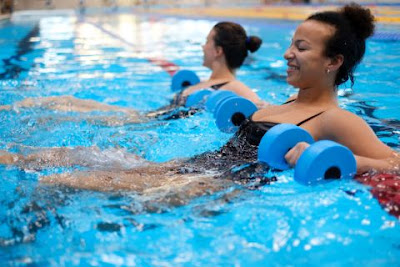In recent times, aquatic therapy has become increasingly popular, and it attracts people because it can reduce body weight by a considerable margin. This aspect helps seniors and injured athletes do cardiovascular exercises, as it is gentle on their joints. While aquatic therapy involves different exercises, you’ll need specific equipment like underwater treadmills if you’re looking to do more challenging workouts.
 |
| Aquatic Therapy |
What Is Aquatic Therapy
It is a type of physical therapy that takes place in water. It is used alongside land-based therapies for patients who experience pain or have trouble doing exercises. The best thing about this therapy is that water’s buoyancy lowers the patient’s weight, making it easy to move and exercise. Since it’s gentle on joints, it suits individuals with joint issues and arthritis.
Since it employs proven methods to enhance the patient’s movement and well-being, it is safe and effective. A certified physical therapist performs this therapy and will create a customised treatment plan for every patient based on their needs and goals. Overall, aquatic therapy helps improve physical functionalities for patients with various conditions. Plus, it’s a great option for patients seeking a supportive, gentle exercise environment.
Prevents Falls
It is hard for people with balance issues to undergo traditional therapy. Here is where water therapy comes into play, as it lowers fall risks and provides a secure environment to exercise safely.
Eases Joint Strain
When you’re in water up to your neck, your body weight gets reduced by 90%, easing pressure on your muscles and joints. This characteristic is excellent for musculoskeletal issues or injuries.
Enhances Coordination and Balance
Aquatic therapy lowers the risk of falls outside the pool, enhancing balance and coordination. Since the water slows movement and minimises falls, it boosts patients’ confidence and helps them regain balance.
Strengthens Muscles and Endurance
Water is denser than air, so an exercise performed on land necessitates more effort if performed in water. Thus, doing land-based exercises in water allows the patients to build endurance and muscle strength.
Increases Joint Flexibility
Water’s incredible support improves how your joints move. On the other hand, warm water relaxes your muscles, making movement more comfortable. It also relieves tension, which is helpful for those dealing with arthritis.
Boosts Aerobic Health
Working out in water improves aerobic capacity, which enhances heart health and blood pressure. These features make the exercise ideal for those with mobility challenges.
Lowers Swelling
When undergoing aquatic therapy, the water exerts hydrostatic pressure (pressure that a confined fluid applies within a specific area) on a patient’s body. Besides enhancing circulation and increasing mobility, this pressure reduces stiffness and swelling.
What You Need for Aquatic Therapy
Aquatic therapy isn’t suitable for everyone. Some individuals with heart conditions might be unable to take part. Also, those dealing with fevers, infections, or bladder issues are unsuitable candidates. Thus, always consult your doctor before starting aquatic therapy. And if you can’t swim, it’s best to avoid pool therapy unless your physical therapist is fully aware and can always assist you. If an injury or illness limits mobility, a skilled physical therapist can aid in a complete recovery. Aquatic therapy can help restore your baseline mobility and return to your usual activities.
Written by Taylor McKnight, Author for ProHealthCareProducts
Enjoy
Richard







No comments:
Post a Comment